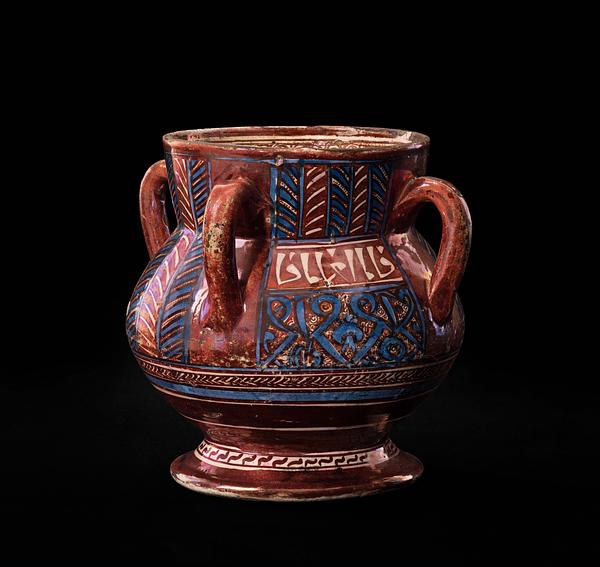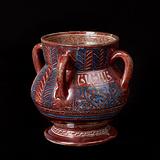Earthenware jar painted with blue in and with lustre over an opaque white glaze
Spain, Valencia (Manises); first half of the 15th century
H: 18.8; Diam (without handles): 18.5 cm
After the Christian reconquest of Islamic Central and Southern Spain between the twelfth and fifteenth centuries, many Muslim potters remained in the area and continued their production of lustreware with Islamic ornamentation. Known as
Hispano-Moresque ware, such pottery was a coveted luxury item in Spain and in the rest of Europe.
With its blue and copper red colours on a white background, this jar is a typical example of Muslim pottery from the town of Manises, close to Valencia (
14/1990 and
32/2005). As in much Islamic art, the decorations are abstract, combining zigzag and herringbone patterns with highly stylised plant ornamentation. The vessel also has a field with pseudo-calligraphy, a meaningless sequence of Arabic letters with purely decorative function. Arabic calligraphy and pseudo-calligraphy were popular forms of ornamentation in the Christian states of Spain and also appear on textiles from the period (
2/1989 and
25/2007).
Inv. no. 11/2021
Published in:
Catalogue des objets d'art et … la collection Emile Gaillard et dont la vente Paris 8.-16. juni 1904, lot 401;
Wilhelm Reinhold Valentiner: ”Spanisch-Maurische Fayencen der Sammlung Beit in London”, Zeitschrift für Bildende Kunst, Neue Folge, XVIII, 1907, p. 120, fig. 4;
Maria M. L. Evans: Lustre Pottery, London 1920, p. 79 (no illustration);
Alice Wilson Frothingham: Catalogue of Hispano-Moresque pottery in the collection of The Hispanic Society of America, New York 1936, p. 125 (no illustration);
Sotheby’s, London, 8/10-1948: The Celebrated Collections of Hispano-Moresque, Italian Majolica Bronzes and Works of Art – The Property of Sir Alfred Beit …, lot 155;
Sam Fogg: Lustreware from Spain – A Collection of Hispano-Moresque Ceramics, [cat.texts Matthew Reeves], Sam Fogg 15. april-7. Maj 2021, London 2021, cat.no. 4, pp. 26 and 28;
Joachim Meyer, Rasmus Bech Olsen and Peter Wandel: Beyond words: calligraphy from the World of Islam, The David Collection, Copenhagen 2024, cat. 35, p. 171;


